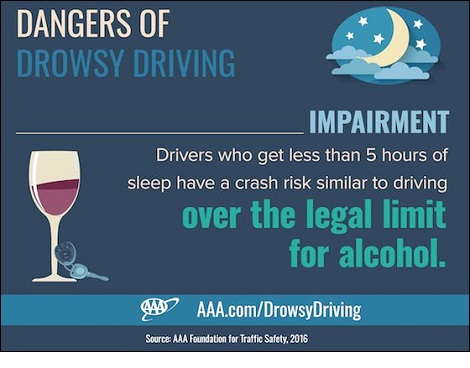
|
|

|
|
| April 19, 2024 |
|
Drowsy drivers can be as dangerous as drunk drivers 
Drivers who miss between one to two hours of the recommended seven hours of sleep in a 24-hour period nearly double their risk for a crash, according to new research from the AAA Foundation for Traffic Safety.
The Centers for Disease Control and Prevention says that 35 percent of U.S. drivers sleep less than the recommended seven hours daily. And with drowsy driving involved in more than one in five fatal crashes on U.S. roadways each year, AAA warns drivers that getting less than seven hours of sleep may have deadly consequences. “You cannot miss sleep and still expect to be able to safely function behind the wheel,” said Dr. David Yang, executive director for the AAA Foundation for Traffic Safety. “Our new research shows that a driver who has slept for less than five hours has a crash risk comparable to someone driving drunk.” The report reveals that drivers missing 2-3 hours of sleep in a 24-hour period more than quadrupled their risk of a crash compared to drivers getting the recommended seven hours of sleep. This is the same crash risk the National Highway Traffic Safety Administration associates with driving over the legal limit for alcohol. The report found that in a 24-hour period, crash risk for sleep-deprived drivers increased steadily when compared to drivers who slept the recommended seven hours or more: · Six to seven hours of sleep: 1.3 times the crash risk · Five to six hours of sleep: 1.9 times the crash risk · Four to five hours of sleep: 4.3 times the crash risk · Less than four hours of sleep: 11.5 times the crash risk “This is a serious traffic safety problem. Each year, crashes involving a drowsy driver result in injuries and fatalities,” said Anita Lorz Villagrana, the Automobile Club of Southern California’s manager of traffic safety and community programs. “Failing to maintain a healthy sleep schedule could mean putting yourself or others on the road at significant risk. Drowsy drivers can experience a lack of alertness, decreased attention span, slowed reaction time and ultimately falling asleep at the wheel.” In 2014 there were 846 fatalities (2.6% of all fatalities) recorded in the National Highway Transportation Safety Administration’s (NHTSA’s) Fatal Analysis Reporting System (FARS) database that were drowsy-driving-related. These reported fatalities (and drowsy-driving crashes overall) have remained largely consistent across the past decade. Between 2005 and 2009 there was an estimated average of 83,000 crashes each year related to drowsy driving. This annual average includes almost 886 fatal crashes (2.5% of all fatal crashes), an estimated 37,000 injury crashes, and an estimated 45,000 property damage only crashes. Symptoms of drowsy driving can include having trouble keeping eyes open, drifting from lanes or not remembering the last few miles driven. However, more than half of drivers involved in fatigue-related crashes experienced no symptoms before falling asleep behind the wheel. AAA urges drivers to not rely on their bodies to provide warning signs of fatigue and should instead prioritize getting plenty of sleep (at least seven hours) in their daily schedules. (INT) Story Date: December 7, 2016
|